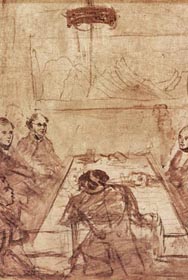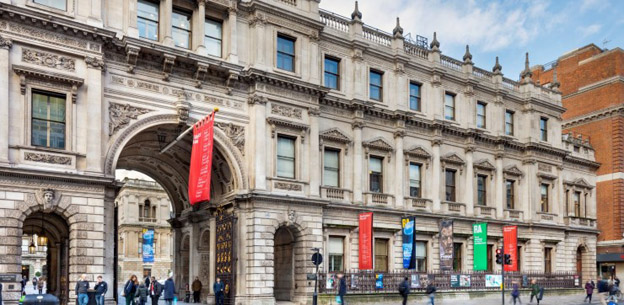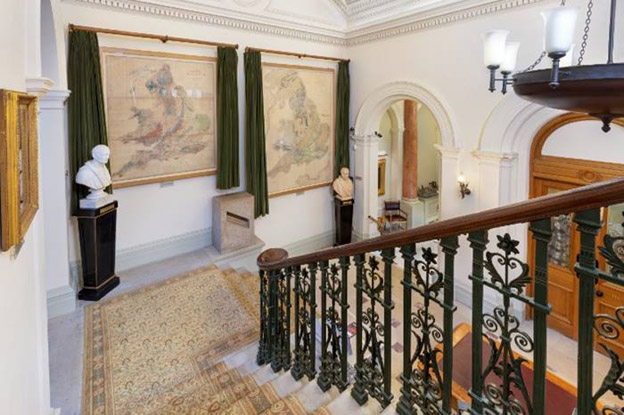The Geological Society was inaugurated on 13 November 1807 at a dinner at the Freemasons Tavern, which formerly stood at the site of the modern Connaught Rooms, Great Queen Street, Covent Garden.

Society Meeting 1830
The minutes of the meeting record that there were thirteen founder members:
- Arthur Aikin (1773-1854)
- William Allen (1770-1843)
- William Babington (1756-1833)
- Humphry Davy (1778-1829)
- Comte Jacques-Louis de Bournon (1751-1825)
- James Franck (d. 1843)
- George Bellas Greenough (1778-1855)
- Richard Knight (1768-1844)
- James Laird (d. 1840)
- James Parkinson (1755-1824)
- William Hasledine Pepys (1775-1856)
- Richard Phillips (1778-1851)
- William Phillips (1773-1828)
This meeting resolved:
"That there be forthwith instituted a Geological Society for the purpose of making geologists acquainted with each other, of stimulating their zeal, of inducing them to adopt one nomenclature, of facilitating the communications of new facts and of ascertaining what is known in their science and what remains to be discovered."
These aims were incorporated in the first constitution of the Society, formally adopted at a meeting on 1 January 1808. Soon after its foundation the Society began to accumulate a library and a collection of minerals, rocks and fossils. These latter were housed in a cabinet presented by Dr William Babington, one of the founder members of the Society. In 1809 the Society moved into rented premises at 4 Garden Court, Temple, and in 1810 to 3 Lincoln's Inn Fields, where it shared larger premises with the Medical and Chirurgical Society.
On 1 June 1810 the Society's first Trustees were appointed and later in the same month, 14 June, the first meeting of the Council took place.The Council resolved that the most important communications made to the Society should be published. Accordingly the first volume of the transactions of the Geological Society was published in 1811.
The original Burlington House was built on the present site of the Royal Academy c.1670 by Sir John Denham for Richard Boyle, 1st Earl of Burlington, 2nd Earl of Cork and Baron Clifford of Londesborough in Yorkshire.
At this time the site of the Society's apartments was occupied by stables that extended from Burlington House to a wall along the Piccadilly frontage. The building was reconstructed c.1731 in Palladian style by the 3rd Earl of Burlington. Subsequently the building passed to the Cavendish family until it was purchased in 1854 by the Government to house The Royal Academy of Arts, The Royal Society and other learned societies.
Additional accommodation was provided in the West and East wings and gateway blocks enclosing The Royal Academy's courtyard, which were completed to the designs of the architects Charles Barry and R R Banks between 1869 and 1873. The exterior of the building is of Portland Stone (Upper Jurassic). From 1860 occasional meetings of the Geological Society were held in Old Burlington House and in 1874 the Society moved to its present apartments.
"The Council have to congratulate the Fellows upon their being at length in possession of the handsome accommodation provided for them by the liberality of the Government..."
(Report of the Council for 1874, Quarterly Geological Journal, 1875, p vi)
In 1911 the Society's mineral and fossil collections, which occupied the present Upper Library, were transferred to the Geological Museum and British Museum (Natural History) at South Kensington. The removal of The Royal Society to Carlton House Terrace (1967) allowed some expansion of the Society's apartments. The old Meeting Room was reconstructed to form the present Lecture Theatre in 1973.
With the increase in membership and activities of the Society it was found necessary to appoint the first permanent officer in 1812; his duties included care of the Library and the Society's collections, as well as those of draughtsman and secretary to the Council and Committees. The continual growth in the membership and of the collections of maps, sections and mineral specimens necessitated a further move in 1816 to 20 Bedford Street, Covent Garden.
As we have seen, the Society started its existence as a dining club but with the increase in the number of members (341 in 1815; 400 in 1818) this aspect of its activities had fallen into abeyance. It was revived in 1824 with the foundation of the Geological Society Club which continues to hold dinners to the present day. (A history of the Club was written by David Gray in 1995).
In 1824 the Council of the Society decided to apply for a Royal Charter. A draft was prepared and on 23 April 1825 the Charter (displayed in the Council Room) was granted, under the Great Seal, by King George IV to the Rev William Buckland, Arthur Aikin, John Bostock MD, George Bellas Greenough and Henry Warburton, who were nominated as the first Fellows of the Society for the purpose of 'Investigating the Mineral Structure of the Earth' and who were empowered to elect other suitably qualified persons as Fellows of the Society. At the following meeting of the Council the existing 367 members of the Society were appointed as Fellows.
The Society continued to meet at 20 Bedford Street until 1828 when it moved to apartments in Somerset House, Strand, which had recently been rebuilt by the Government for use as public offices and to house the Royal Academy and the Royal Society.
The Geological Society's apartments, including the two rooms of the museum, were fitted out to designs of Decimus Burton, architect of the Temperate House at Kew Gardens, who was a Fellow of the Society. The first meeting at Somerset House was held on 7 November 1828, and the Society remained there until removal to the present apartments at Burlington House in 1874.
The first female Fellows
Following the 1918 Representation of the People act, the Geological Society’s Council appointed a committee to consider
‘The most convenient and expeditious way of effecting the admission of women into the Society.’
A simple amendment was made to the byelaws:
"Article XXIII. Interpretation – In the interpretation of these Bye-Laws words in the masculine gender only, shall include the feminine gender also."
On 21 May 1919, eight women were elected as Fellows of the Geological Society:
- Margaret Crosfield (1859-1952)
- Gertrude Elles (1872-1960)
- Maria Matilda Gordon (1864-1939)
- Mary Sophia Jonston (1875-1955)
- Mary Jane Donald (1855-1935)
- Rachel MacRobert (1884-1954)
- Mildred Blanche Robinson (1865-1935)
- Ethel Gertrude Skeats (1865-1939)

Burlington House
Since 1874, Burlington House has been home to the Geological Society, the Linnean Society, the Society of Antiquaries, the Royal Society of Chemistry, the Royal Astronomical Society, and the Royal Academy of Arts, as a meeting place for the arts and sciences.
Geological Society Publishing
The Geological Society has a long and successful track record as a significant publisher of geological content, starting only four years after the Society’s inception and continuing without break to the present day.
The Geological Society’s earliest serial publication, Transactions of the Geological Society of London, was first produced in 1811 with William Phillips as publisher. In 1821 the Society became its own publisher until 1856, when the series ended.
It was supplanted by the Quarterly Journal of the Geological Society (QJGS) which, from its start in 1845, was published for the Society by Longman, Brown, Green & Longman (later becoming Longman, Green & Co. Ltd) – an arrangement which lasted for over 100 years, until 1951. The Quarterly Journal of the Geological Society included the Proceedings of the Society, which then met fortnightly from early November until late June.
The William Smith Map
In our hallway hangs a copy of William Smith’s (1769-1839) map 'A Delineation of the Strata of England and Wales, with part of Scotland, exhibiting the Collieries and Mines, the Marshes and Fenland, originally overflowed by the Sea, and varieties of soil according to the Variations in the Substrata, illustrated by the Most Descriptive Names…’ published by John Cary (1815).

Both maps can be viewed Tuesday-Thursday, 9.30am-5pm. No appointment is necessary.
Considered to be the first geological map of a complete country ever made, Smith’s innovation was to attempt to classify rocks according to age and manner of deposition—that is stratigraphically. Fundamental to the production of the map was Smith’s recognition that particular fossils were associated with specific strata, thus enabling rocks to be correlated across country. During his travels up and down the country working as a surveyor and engineer, Smith recorded the rocks that he saw. Much of the geology on his map is therefore from first hand observations.
Beside Smith’s map is another geological map produced under the authorship of the Society’s first President George Bellas Greenough (1778-1855). As it was published not long after in 1820 (although the date engraved on the map is November 1819), it has been described as a rival to Smith’s map notably in Simon Winchester's book 'The Map that Changed the World' (2001).
Much has been written about to what extent Smith’s Map influenced Greenough but the reality is far more complicated. Greenough’s map is actually more accurate because he used multiple sources, whilst Smith, strictly bound by his stratigraphical theories, would add strata in areas where he presumed they must be but did not in fact exist.
KeyFacts Energy Industry Directory: The Geological Society
 KEYFACT Energy
KEYFACT Energy